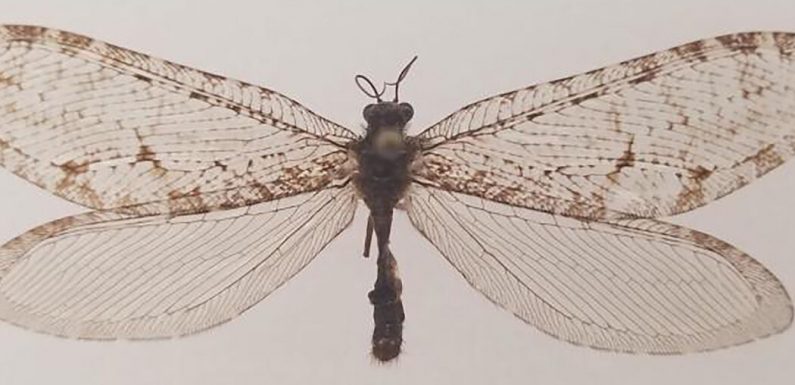
It took the Covid-19 pandemic and a class held on Zoom for the entomologist to give a long-forgotten insect specimen another look.
With the world in lockdown in the fall of 2020, Michael Skvarla, an assistant research professor at Penn State University, turned to his private collection, the two cabinets full of insects he kept at home, to show students how to compare insect characteristics.
He unearthed for the camera-connected microscope a specimen he had found back in 2012 clinging to the outside wall of a Walmart in Fayetteville, Ark., and asked students to examine the characteristics of the antlion, a dragonfly-like predator.
Except that this bug, with its nearly two-inch wingspan, was way too big to be an antlion.
“It didn’t have clubbed antennae like it should. It didn’t have lots of cross-veins in the wing like it should,” Dr. Skvarla recalled in an interview.
“So the immediate question was: What is this thing?”
Dr. Skvarla and his students compared features, quickly concluding, live on Zoom, that it was another species that was thought extinct in eastern North America.
The giant lacewing, or Polystoechotes punctata, is a large insect from the Jurassic Era. It was once widespread, but mysteriously disappeared from eastern North America sometime in the 1950s.
The specimen found at the Walmart represents the first recorded in eastern North America in more than half a century, and the first ever recorded in Arkansas.
In a peer-reviewed study published late last year by the Entomological Society of Washington that has only recently been publicized, Dr. Skvarla and a co-author, J. Ray Fisher of Mississippi State University, speculated that the insect could have disappeared with growing light pollution, too little fire smoke (which historical records suggest they like) and the introduction of non-native predators to the region.
Northwestern Arkansas, where the Walmart is located, falls within the Ozark Mountains, an under-studied biodiversity hotspot, said Dr. Skvarla. While it is possible that the lacewing he found hitched a ride on a long-haul truck or hid in rail freight with goods bound for his local Walmart, his favorite hypothesis is that the insect belonged to a relic population that has quietly persisted, evading detection over the past half-century, just waiting to be found.
Yet repeated expeditions back to the Fayetteville Walmart and the surrounding forest by Dr. Fisher and some of his colleagues have yet to yield any more giant lacewing finds.
Still, to Robert Dowell, a fellow emeritus at the California Academy of Sciences, a nonprofit museum in San Francisco, the discovery “suggests that there are likely other small populations of the insect holding on in wooded areas in the East.”
The insect’s discovery raises more questions than it answers.
That a giant lacewing population could have existed in Eastern North America in the internet era without anyone realizing is all the more remarkable because of the avid citizen biologists who use apps like iNaturalist to share photos and compare notes on flora and fauna, providing “a near real-time picture of the distribution of a wide range of animals and plants,” Dr. Dowell said.
But there is precedent for the rediscovery of giant lacewings.
In 1924, a specimen was found in Chile, 65 years after the only other known example of that type was collected. And a new species of Adamsiana, a related genus, was spotted in Guatemala in 2020.
Even in parts of the world where populations remain, such as the western United States, it is possible to go years or even decades without a sighting, Dr. Skvarla said.
“It’s not unprecedented, but within the narrative of them being gone from the East," Dr. Skvarla said, “it’s the wonder of discovery.”
Source: Read Full Article